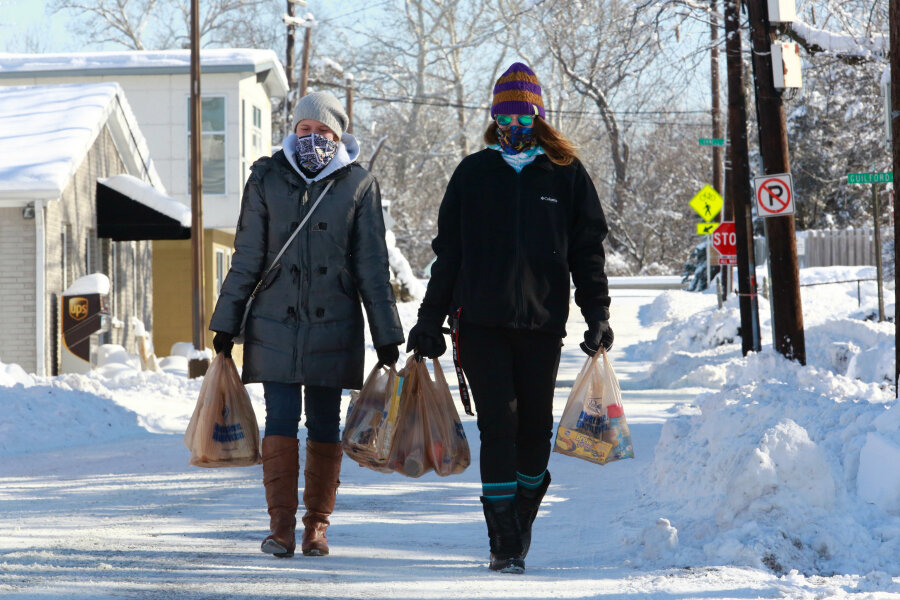Could produce on wheels help eliminate America’s food deserts?
Loading...
When it comes to supermarkets, most of us have an abundance of choices. Big-box chains compete for customers with aisles chock-full of everything from Greek yogurt to chicken sausage.
Not everyone is so lucky; in the U.S., 23.5 million people live in food deserts, which means they live 10 miles from a supermarket. For these Americans, picking up fresh oranges or a gallon of milk is a huge challenge.
Entrepreneur Amelia Pape wanted to figure out how to bring fresh produce to these underserved markets but was daunted by the staggering amount of capital needed to stock and open a grocery store. So in 2011, she launched My Street Grocery, a mobile grocery truck that operates as a pop-up market.
A few years later, Pape approached Whole Foods Market to discuss ways to make a greater community impact. In 2014, with the help of Whole Foods Market, My Street Grocery relaunched as a mobile grocery trolley open four days week, servicing food desert communities around Pape’s hometown of Portland, Oregon.
The trolley is stocked with fresh, affordable produce, 365 brand pantry staples, on-site cooking demos, and more than you’d imagine could fit on four wheels. We caught up with Pape to discuss social enterprise, how she copes with space limitations, and the inherent gratification of sharing good food.
TakePart: How and why did you start My Street Grocery?
Amelia Pape: I began working on the concept during graduate school, where I had a chance to do in-depth research, write a detailed business plan, and build industry contacts. It began as an exploratory project about food access, but when I realized that it was a convergence of my passions—food, community, and innovation—I decided to pursue it as a business.
TakePart: Do you and/or the company have a guiding ethos or mission?
Pape: My Street Grocery is a social enterprise, meaning we are using a market-based solution to address a social problem. Our mantra, “Food is community,” speaks to the belief that all communities deserve access to nourishing food and the quality of life that it provides. Our purpose is to improve access to affordable healthy foods in underserved populations. We also promote personal well-being by providing cooking and nutrition support and building community through partnerships that celebrate the joy of good food.
TakePart: Tell us a little bit about the cooking and nutrition support.
Pape: Many of our clinic partners provide nutrition and cooking classes in conjunction with the [Prescription Food Voucher Program]. We also conduct on-site cooking demos ourselves to help customers envision how to utilize a particular product we carry. Our Meal Kits are kits that include ingredients and a recipe card to prepare a healthy meal at home. These are useful educational tools for customers who find a cooking class to be a scheduling challenge.
TakePart: What are some of the challenges that you’ve encountered functioning as a mobile grocery store?
Pape: Limited space is a challenge for us, so we have really learned to maximize it. We have a back stock refrigerator onboard and some custom storage shelves above our grocery racks. Our passenger seats fold up when we’re parked, and the cash register pivots to turn the cab into a point-of-sale station. We’re continuing to improve upon the design and operational efficiencies of the mobile store, and I’m confident that the next iteration will be even better.
TakePart: What is the most gratifying part of the job?
Pape: We often hear from customers about how helpful the service is to them, which really validates the work. It’s gratifying to see a community building around us, to be a part of that, and to forge relationships with our customers. One of our longtime customers is a talented craftswoman who made me a special charm to hang inside the trolley. Another baked cookies for our staff and brought them to the market. Another wrote a letter expressing his gratitude for our program. In the letter, he said he considered us a part of his support system.
TakePart: What’s on the horizon for My Street Grocery?
Pape: We’re on our second version of the mobile store. The first was a simple box truck with modular shelving that we pulled outside and set up under a little tent. Our current model is a repurposed trolley car named Molly, which offers an indoor shopping experience. Fresh produce is our focal point, but we now have glass-door refrigerators and freezers, so customers can shop for everything from dairy to meats to frozen fruit and veggies.
Our goal is to serve more communities throughout the Pacific Northwest region and to add more mobile models to our program, but it’s important to us that we grow responsibly. Right now, we are focusing on our program here in Portland, our home. Our decision to expand into a new location is collaborative with the community and one based on relationship building. This is not a process that can or should be rushed. We also have plans for some exciting new programs that will support our market service and contribute to our holistic access approach. Stay tuned!
Find weekly trolley schedules on mystreetgrocery.com or on Twitter: @mystreetgrocery.
(Quotes have been edited for space and clarity.)
• Zinzi Edmundson is a Los Angeles-based lifestyle writer and editor. She's contributed to Bon Appétit, Refinery29, Studio@Gawker, and Dwell among others.
• This article originally appeared at TakePart, a leading source of socially relevant news, features, opinion, entertainment, and information – all focused on the issues that shape our lives. Visit takepart.com/start-from-the-source.
Related stories from TakePart
Inside L.A.'s Landmark Vegan Paradise
Can Vegetables Get Vertigo? Brooklyn’s Newest Farm Makes the Most of Rooftop Real Estate







